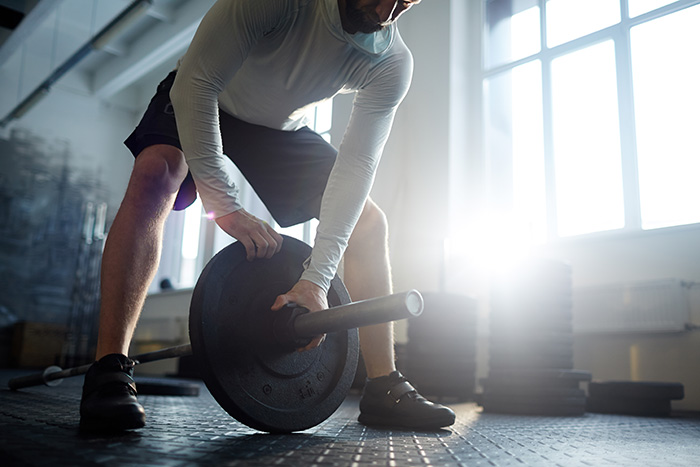Use the landmine row to build big arms and a defined back
Add the landmine row to your back and biceps training toolkit to build a bigger, stronger and more defined upper body, says New Body Plan fitness editor Joe Warner
The landmine row is another one of those unloved exercises, much like its upper-body counterpart the landmine press, that needs to feature in any gym training plan. If it doesn’t feature in yours you’re missing out on some serious muscle-building potential.
The landmine row often gets ignored in favour of more popular moves that are easier to set up and do. Give most people the option and almost everyone will choose the lat pulldown or seated row – even the barbell bent-over row – rather than the landline row. But this lift offers a range of benefits it’s hard to replicate with these more common upper back exercises.
That’s why I urge you to think about adding the landline row to your next back and biceps workout. Give it a go and see how it feels. I bet you’ll find it hits your upper back and biceps in a way you’ve not felt before. And it’s the working of your target muscles in new ways that’s the key to growing bigger, stronger and more defined muscles!
What is the landmine row?
The landmine row is a fantastic upper back exercise that often gets overlooked for more well-known lifts. These include the assisted pull-up, lat pulldown and cable seated row, all of which are machine moves, so are very simple to set up and adjust the weight. And body-supported moves, such as the chest-supported dumbbell row, or more demanding lifts, such as the bent over row or bodyweight chin-up.
What equipment do I need to do a landmine row?
Setting up the landmine row requires a little bit of effort. But you’ll be well rewarded for the way it works your upper back and biceps. You’ll need a landmine holder, an Olympic barbell and some weight plates. How many plates depends on how strong you are!
All good gyms should have a landmine holder unit secured to their power racks or squat cages. But you can get standalone landmine units that can be moved around the gym floor. If your gym only has barbells and weight plates and no specialist landmine holder you can position one end of the barbell in the corner between two walls.
How is the landmine row different to a T-bar row?
The landmine row and T-bar row are very similar exercises that work the target muscles almost identically. Indeed, some gym rats use the two exercise names interchangeably. Some gyms will have a T-bar machine, on which you can support your chest on a padded bench.
You will still work your upper back and biceps in a similar way as with the landmine row, but having your torso supported on the bench reduces the recruitment of your abs, lower back and glutes. This may allow you to lift heavier more safely, which is why you should do landmine rows and use the T-bar machine in your training programme, if your gym has the kit.
What muscles does the landmine row work?
The landmine row works many major muscle groups. The main muscles worked are the muscles of your upper back. These include the latissimus dorsi, rhomboids and trapezius. Your rear shoulders are also involved, as are your biceps and forearms.
What’s more you’ll also recruit the stabilising muscles of your abs, lower back and glutes. They must all work together to keep your torso stable and locked in position as your lift and lower the weight with each rep. It really does hit a lot of key muscles in just one movement!
Can I do the landmine row one-handed?
Yes, you can. Unilateral, or single-limb, exercises should form a significant part of your training. And the one-arm landmine row is a fantastic exercise to work and improve any muscular imbalances you have. You’ll obviously need to lift a lot lighter than when using both hands. But focus on great form and a full range of motion and you’ll make significant progress.
Follow the form guide below, except stand to one side of the bar, hinge down and grip it with one hand, and row it up and down to that side of your body.
How do I do the landmine press?
• Add the required weight to the landmined barbell then stand over the middle of the bar, facing towards the end with the weight plates and away from the anchored end.
• Bend your knees slightly, hinge forwards from your hips then grip the barbell with both hands with your arms fully straight.
• You can grip a handle secured to the bar instead of holding the bar with your hands, if you have that option available. A narrow grip will work your upper back differently to a wide grip.
• Keeping your back straight and abs engaged, row the bar up towards your chest, leading with your elbows.
• Your aim is to keep your head and torso stable and locked in position – only your arms should move.
• Pause in the top position for at least a second, then slowly lower the bar back down to the start position under complete control until your arms are straight.
• That’s one rep. Depending on whether you’re training for muscle strength or muscle size, do 3-4 sets of between 5 and 15 reps, resting at least one minute between sets.
Find your perfect fat-loss plan!
Take the New Body quiz!
Use cable machines to build muscle and burn fat to build a better body
Burn fat and lose your belly with the best cardio for weight loss
Torch fat and add lean muscle with this dumbbell HIIT workout

